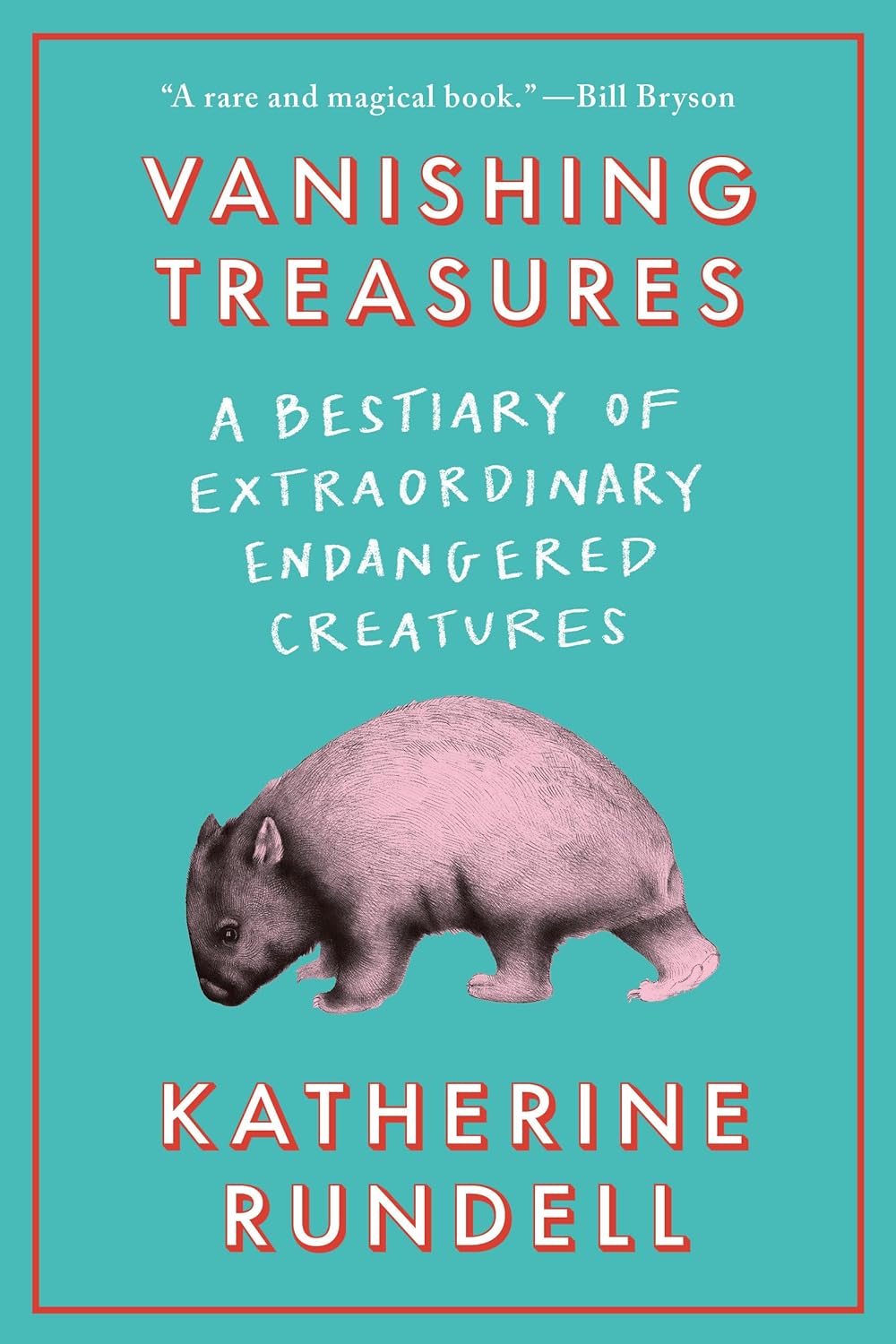Vanishing Treasures: A Bestiary of Extraordinary Endangered Creatures
- By Katherine Rundell
- Doubleday
- 224 pp.
- Reviewed by Gretchen Lida
- December 13, 2024
An enchanting, erudite ode to the imperiled animals around us.

Katherine Rundell’s Vanishing Treasures received a bit of a makeover for its American debut. The essay collection’s original 2022 title, The Golden Mole, was changed, and a wombat now graces the cover instead of the book’s original namesake. Its updated subtitle, “A Bestiary of Extraordinary Endangered Creatures,” refers to a type of medieval encyclopedia of wildlife. A bestiary was an illuminated manuscript in which each animal was depicted as being a testament to God’s will. In Vanishing Treasures, however, Rundell leaves Christianity in the archives and leaves us in awe of the creatures themselves.
The author, the youngest female fellow at All Souls College, Oxford, also leaves aside any overly heavy scholarship (in case this review’s opening paragraph left you worried the book would be too erudite for us plebians). Rundell mostly writes YA novels, but the nonfiction Vanishing Treasures is a joy for grownups. From essays on the sea horse to the giraffe, each brief entry balances poetry, science, and history to create something both beautiful to read and necessary for this pivotal ecological moment.
In his 1995 piece, “The Trouble with Wilderness,” environmental historian William Cronon argues that part of the reason we’re facing ecological destruction is that we’ve created a false binary between the natural world and the human one. Such a binary plays out in nature writing, too. Good nature writing walks a highwire between the human narrative and the facts about our nonhuman kin. Without enough human experience or insight, a piece can feel brittle and textbook-like; without enough nature, the reader feels shortchanged.
Rundell takes these binaries, sticks her tongue out at them, and then smashes them to pieces with her intense research and gorgeous sentences. For instance, in her essay about swifts — tiny birds that rarely land — she notes it was Chaucer who first remarked they must sleep with one eye open, which people found ludicrous at the time. Yet we now know that swifts do, indeed, sleep in the sky; half of their brain stays awake to fly, while the other half “naps.” In Rundell’s hands, the borders between history, art, science, and nature collapse, unveiling the truth that these boundaries have always been a construct of our own creation.
Somehow, the prose also balances the acknowledgement of awe-inspiring, life-affirming beauty with a “let’s not take ourselves too seriously” playfulness. In some passages, you can almost hear the author grinning. “Lemurs are strange in the way that the reclusive and wealthy are strange,” writes Rundell in one. “[H]aving the island to themselves to evolve in, they have idiosyncratic habits.”
Another challenge for books like Vanishing Treasures is that they often crumble under the weight of their own enthusiasm. Lists of facts can run off with the reader, making it hard for any single detail to stick. To combat this, the narrative container organizing all the interesting bits must be sturdy and well thought out. Here again, Rundell understands the assignment by understanding the human brain’s thirst for connections. While every essay is about a different animal, she is careful to connect each one to a person, event, or idea. Thus, to illustrate the magic of narwals, she highlights their tie to unicorns. When describing wombats, she shares how the Victorian painter Dante Gabriel Rossetti adored the pouched critters.
In keeping with the tradition of the bestiary, each chapter includes a stunning illustration of the animal up for discussion. Throughout, artist Talya Baldwin avoids gimmickry by employing a combination of hyperrealism and whimsy in her drawings. The images also have a grounding and focusing effect, giving the prose an extra boost of clarity (even if we think we know the animal we’re reading about).
Lastly, Rundell isn’t shy about elucidating the threats from climate change and habitat loss facing these creatures. In light of the ongoing sixth mass extinction — which has seen a loss of 69 percent of the world’s biodiversity since 1970 — it would be tone-deaf to do otherwise. Still, Vanishing Treasures isn’t a work of doom, it is one of awe. “[T]his book has been a wooing,” Rundell writes. “It has been an asking for your wonder and attention.” By never descending into cynicism or helplessness, it has earned both.
Gretchen Lida is an essayist and an equestrian. Her work has appeared in the Washington Post, the Rumpus, the Los Angeles Review of Books, and many other publications. She is a contributing writer at Horse Network and the Independent, and host of “HN Reads,” a podcast about horse books. She lives in Chicago.
